This post may contain affiliate links. For more information, please see our affiliate policy.
After the feast, turn the leftover turkey carcass into a rich, flavorful broth using some simple vegetables and herbs. You’ll have about 2 quarts of homemade turkey broth, perfect for freezing or making soup.
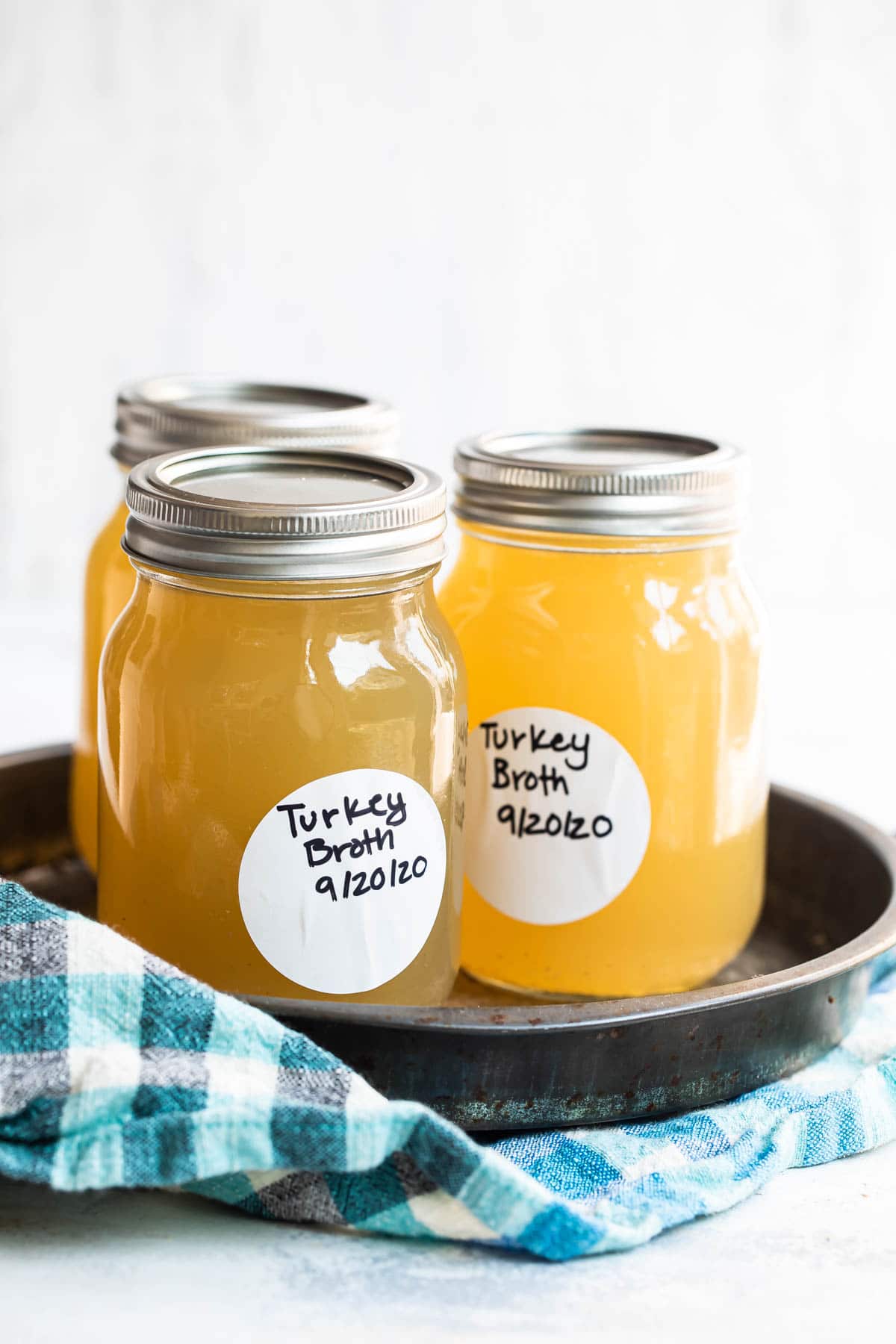
Even if I’m a guest at Thanksgiving dinner, I secretly hope someone offers me the leftover carcass just so that I can make this broth. Yep, I’m that person toting the bones home. Not sad about it at all.
And why not when you can eke every last bit of flavor from the Thanksgiving bird? Turkey broth makes amazing soups, like leftover turkey noodle soup, but can also be used in place of chicken broth in all your favorite recipes.
Table of Contents
Recipe ingredients
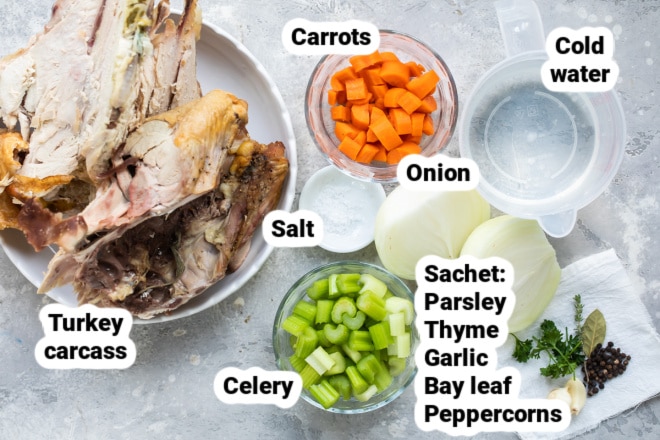
At a Glance: Here is a quick snapshot of what ingredients are in this recipe.
Please see the recipe card below for specific quantities.
Ingredient notes
- Turkey carcass: Bones and all. To help the turkey fit in a pot, cut it into 4 or 5 pieces with kitchen shears or a knife.
- Organ meats: The heart and gizzard can be added to the broth if desired, but the liver should be discarded or reserved for another purpose.
- Cold water: Always start with cold water. This helps keep the broth clear, not cloudy. The amount of water used and the length of simmering time will determine the intensity of the broth.
- Vegetables: Some cooks save old vegetable trimmings to add to their broth. I prefer to start with new, fresh vegetables because I think the broth will taste better. So yes, we peel the carrots, and save your vegetable scraps for composting!
- Herbs and spices: A sachet is a fancy term for parsley stems, thyme, bay leaves, peppercorns, and optionally, garlic or cloves, tied up in a piece of cheesecloth with twine. You could also use a tea ball or loose-leaf tea bag to hold them. It makes it easier to pull these small ingredients out of the broth later. Or, you can just add everything straight to the pot since you strain the broth at the end.
Step-by-step instructions
- To a Dutch oven or large stock pot, add turkey carcass and enough cold water to cover it (see note 2). Over medium-high heat, bring to a boil. Immediately reduce heat to low and skim the foam off the top.
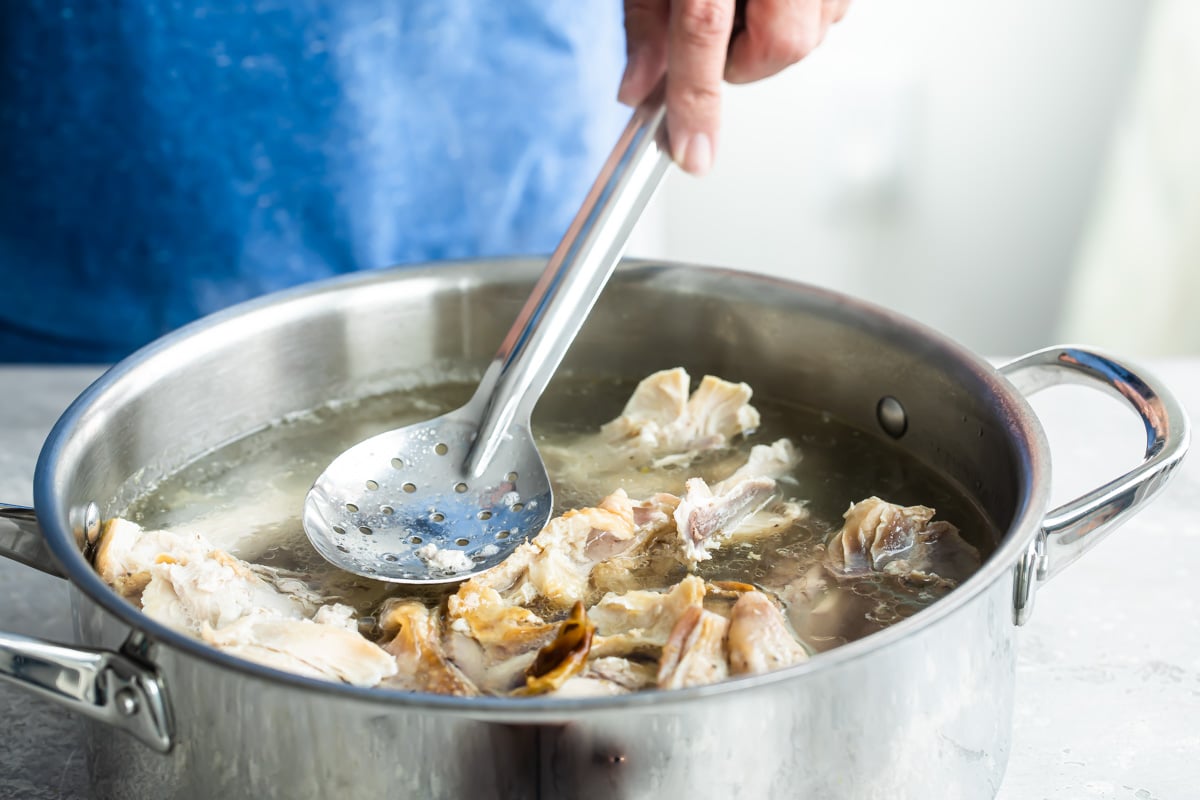
- To the pot add onion, carrot, celery, and salt. If desired, tie parsley stems, thyme, garlic, bay leaf, and peppercorns to make a sachet or add loosely to the pot. Simmer gently (bubbles should barely break the surface at irregular intervals) until the turkey has released its flavor, at least 1 hour or up to 4 hours. The longer the broth simmers, the more flavor it will have.
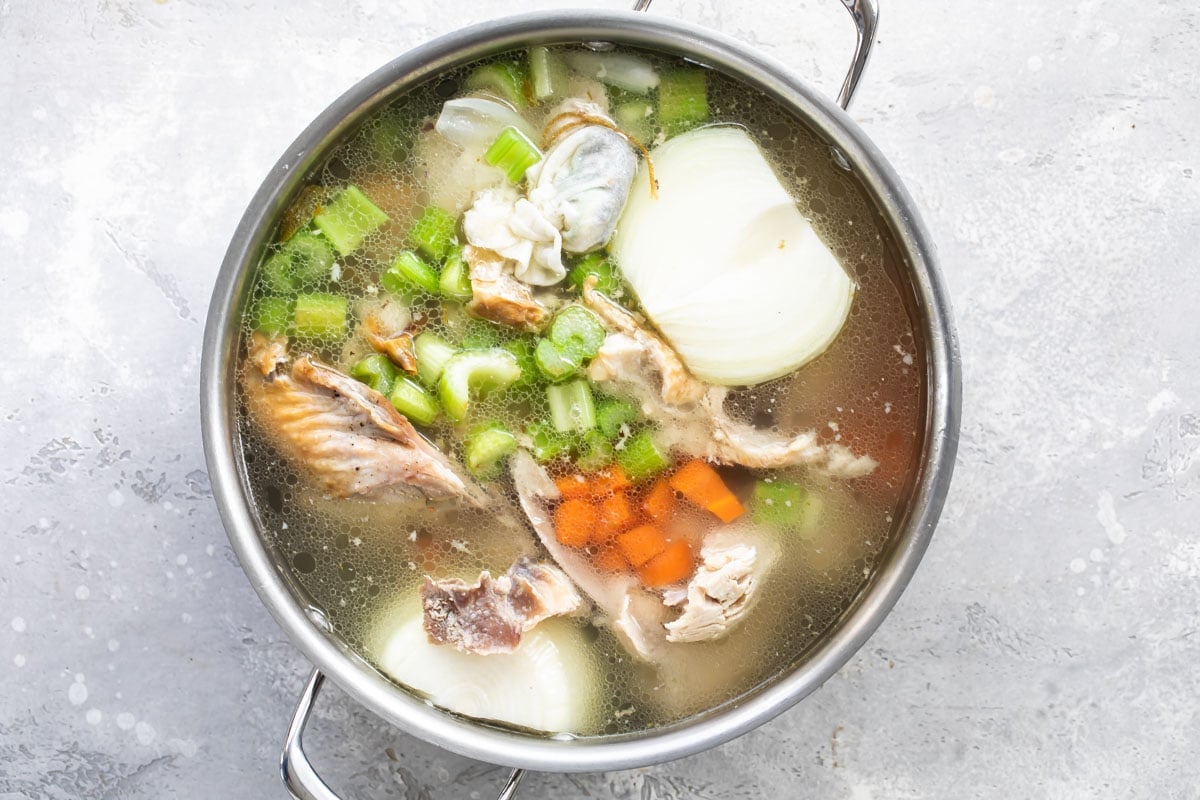
- Strain the broth through a fine-mesh strainer or cheesecloth. Place in a large bowl and chill covered overnight in the refrigerator.

- The next day, scrape off the accumulated fat from the top of the stock and discard. Divide the broth into freezer-safe containers (leaving at least 1/2-inch for expansion), label, and freeze. Or, refrigerate and use within 4 days.
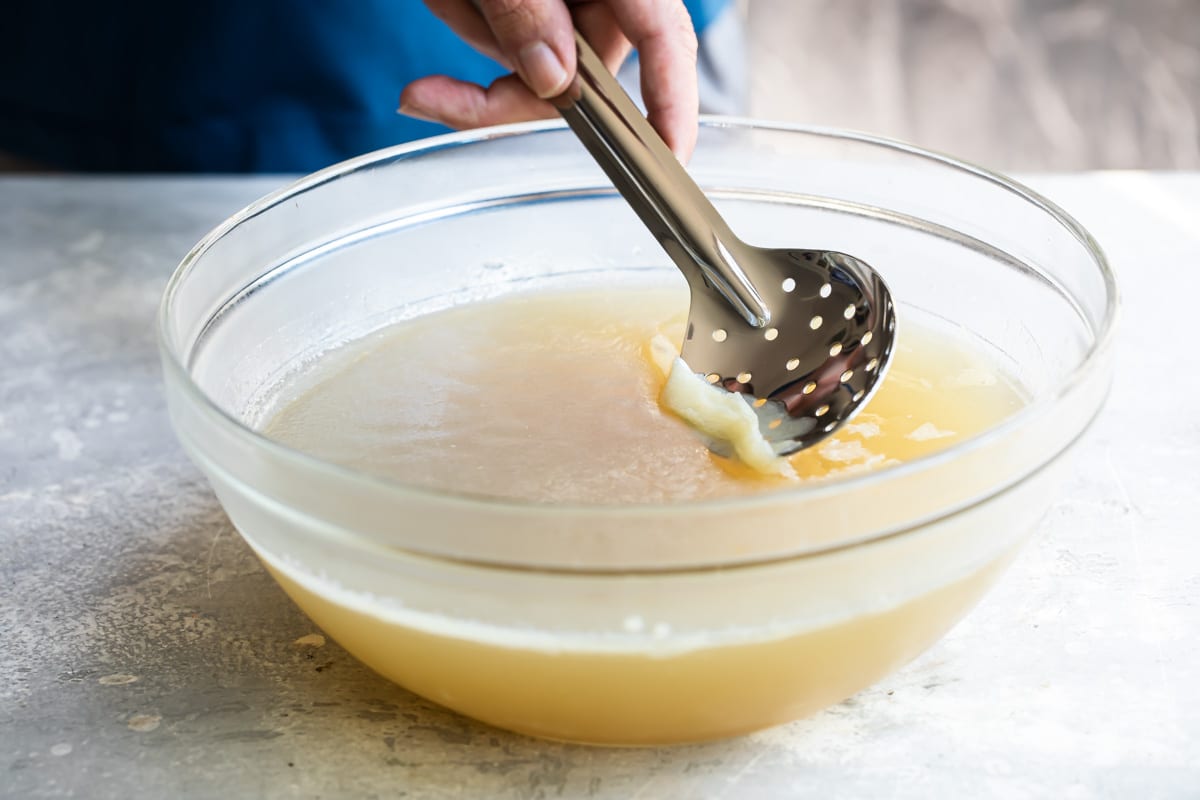
Recipe tips and variations
- Yield: This recipe makes about 8 cups (2 quarts) of turkey broth.
- Storage: Store turkey broth in the refrigerator and use within 4 days.
- Freezer: Divide the broth into freezer-safe containers (I like to use 16-ounce glass jars) and leave 1/2-inch head space for expansion. Label and date, then freeze for up to 3 months. Thaw overnight in the refrigerator.
- Turkey stock vs. broth: Technically, stock is made with just bones, while broth is made with bones and meat.
More delicious soups to try
Soup and Stew Recipes
Leftover Turkey Noodle Soup
Soup and Stew Recipes
White Turkey Chili
Soup and Stew Recipes
Homemade Chicken Noodle Soup
Soup and Stew Recipes
Chicken Tortellini Soup
Join Us
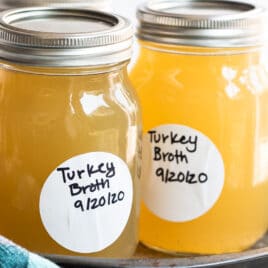
How to Make Turkey Broth
Ingredients
- 1 roasted turkey carcass cut into pieces (see note 1 & 2)
- Cold water about 12 cups (see note 3)
- 1 medium onion peeled and halved
- 1 large carrot peeled and coarsely chopped (see note 4)
- 1 celery rib coarsely chopped
- 1 tablespoon salt
Sachet (see note 5):
- 6 fresh parsley stems
- 1 sprig fresh thyme
- 2 cloves garlic
- 1 bay leaf
- 1 teaspoon whole black peppercorns
Instructions
- To a Dutch oven or large stock pot, add turkey carcass and enough cold water to cover it (see note 2).
- Over medium-high heat, bring to a boil. Immediately reduce heat to low and skim the foam off the top.
- To the pot add onion, carrot, celery, and salt. If desired, tie parsley stems, thyme, garlic, bay leaf, and peppercorns to make a sachet or add loosely to the pot (see note 5).
- Simmer gently (bubbles should barely break the surface at irregular intervals) until the turkey has released its flavor, at least 1 hour or up to 4 hours. The longer the broth simmers, the more flavor it will have.
- Strain the broth through a fine-mesh strainer or cheesecloth. Place in a large bowl and chill covered overnight in the refrigerator.
- The next day, scrape off the accumulated fat from the top of the stock and discard. Divide the broth into freezer-safe containers (leaving at least 1/2-inch for expansion), label, and freeze. Or, refrigerate and use within 4 days.
Recipe Video
Notes
- Turkey carcass: Bones and all. To help the turkey fit in a pot, cut it into 4 or 5 pieces with kitchen shears or a knife.
- Organ meats: The heart and gizzard can be added to the broth if desired, but the liver should be discarded or reserved for another purpose.
- Cold water: Always start with cold water. This helps keep the broth clear, not cloudy. The amount of water used and the length of simmering time will determine the intensity of the broth.
- Vegetables: Some cooks save old vegetable trimmings to add to their broth. I prefer to start with new, fresh vegetables because I think the broth will taste better. So yes, we peel the carrots, and save your vegetable scraps for composting!
- Herbs and spices: A sachet is a fancy term for parsley stems, thyme, bay leaves, peppercorns, and optionally, garlic or cloves, tied up in a piece of cheesecloth with twine. You could also use a tea ball or loose leaf tea bag to hold them. It makes it easier to pull these small ingredients out of the broth later. Or, you can just add everything straight to the pot since you strain the broth at the end.
- Yield: This recipe makes about 8 cups (2 quarts) turkey broth.
- Storage: Store turkey broth in the refrigerator and use within 4 days.
- Freezer: Divide the broth into freezer-safe containers (I like to use 16-ounce glass jars) and leave 1/2-inch head space for expansion. Label and date, then freeze for up to 3 months. Thaw overnight in the refrigerator.
Nutrition
Meggan Hill is a classically-trained chef and professional writer. Her meticulously-tested recipes and detailed tutorials bring confidence and success to home cooks everywhere. Meggan has been featured on NPR, HuffPost, FoxNews, LA Times, and more.
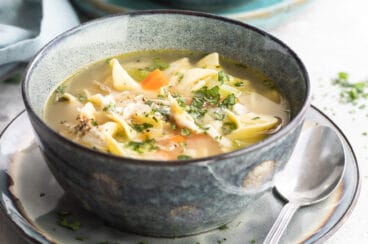


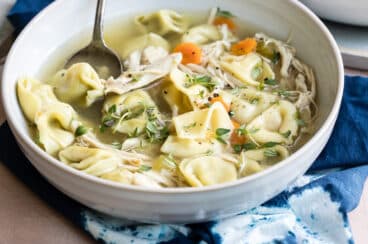
I cut up three fresh turkeys and froze them in parts, then used the raw carcasses to make broth. I used a 10qt pressure cooker and cooked it for 2 hrs. It made perfectly balanced broth. Making the second batch with the rest of the carcasses today. Thanks!
You’re welcome, Ceri! Thank you so much for sharing your tips! – Meggan
Is there any way to CAN process broth? My freezer soace is at a primo and i never seem to think ahead enough to lee something like this thaw before needing it.
Hi Susan, thank you for your question. I am not a canning expert, and haven’t tried canning this myself. I would recommend following a recipe developed specifically for canning, or follow these guidelines from the National Center for Home Food Preservation: https://nchfp.uga.edu/how/can_05/stock_broth.html. I hope this helps! – Meggan
I’m such a dork! I filled my stock pot with water to the cover of the pot. I think it’s supposed to be to cover the bones. I’ll do better next time 🙂
Hi Pete! Mistakes happen! It will all work out! I’ve clarified it a little better in the post, so hopefully it doesn’t happen to someone else. Thanks for taking the time to write, I hope you love this broth! – Meggan
Turned out great!
Thanks for your comment, Kimberly! I’m so glad it turned out well! – Meggan
Is it okay if we don’t have the bones? Can I use just the turkey meat?
Hi Annie, I’m sorry, I haven’t tried making turkey broth without the bones. Sorry! I think it will taste flat since it is not getting the flavor or gelatin from the bones. – Meggan
This is my first time making broth. I had to add water (16c total) to cover all my turkey parts, and added a little more carrot and celery to make up for it. I’m about 2 hours in and it tastes soooo good (especially on this cold late November night). I’m totally kicking myself for not doing this sooner. Highly recommend and will be making a lot more broth from here on out. Thanks, Meggan!
Hi Kiya, you’re so welcome! Sounds like you had quite a big turkey this year! So happy you enjoyed it, especially on a cold night. Take care! – Meggan
First time making any broth. It was super easy and yielded an amazing broth that had great depth me flavor. I used it to make turkey noodle soup. I will be using this again for not only turkey, but also chicken.